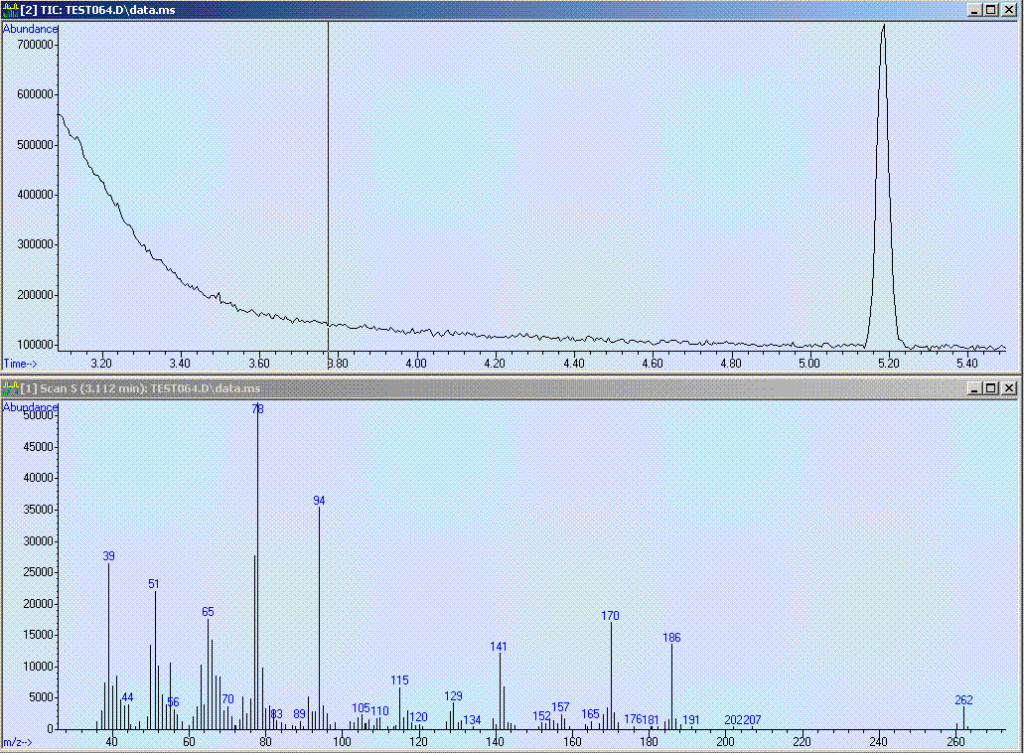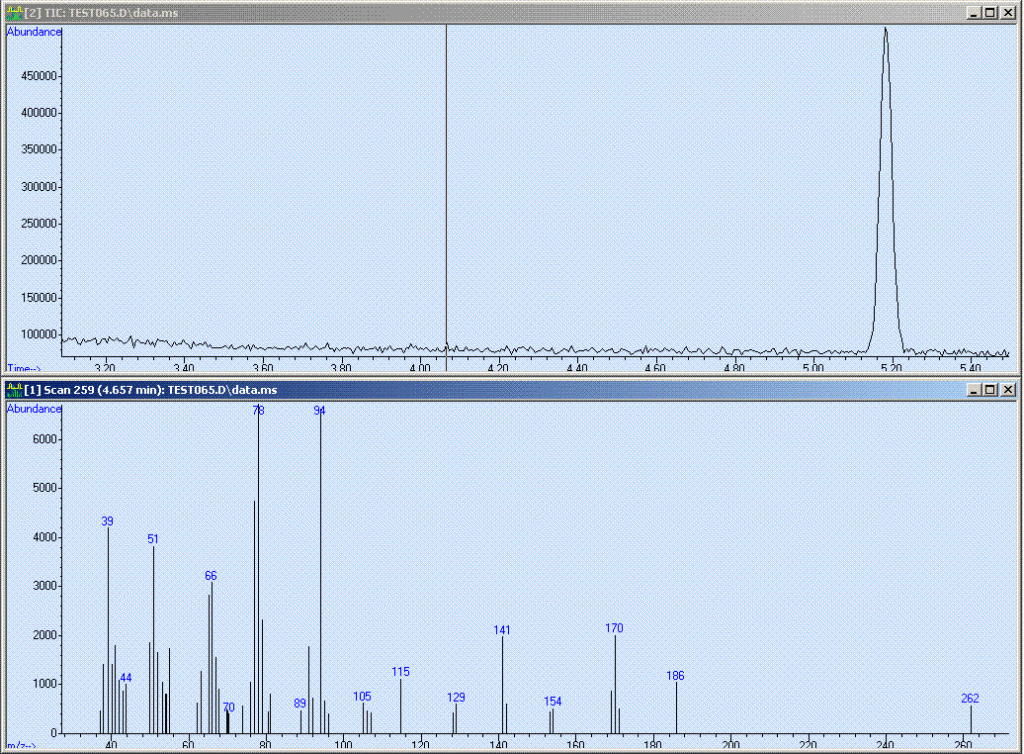Page 1 of 1
Hydrogen carrier for GC/MS-getting closer to making it work
Posted: Wed Jul 03, 2013 3:10 pm
by James_Ball
Still trying to make Hydrogen work as a carrier for doing environmental work, can sometimes get it to pass the BFB tune now thanks to some suggestions from Mr. Valentine here who suggested lowering the flow.
What I am dealing with now is some kind of background contamination I see when using hydrogen but not when using helium.
Two injections of BFB gave these results


I can't quite figure out what that background spectra is, and it seems to build up on the filaments over night as it is the same spectra in the raised portion at the beginning of the first chromatogram that goes away with the second injection. I have added a moisture and oxygen trap to the gas line, may try adding a hydrocarbon trap also just in case it is something coming from the hydrogen tank. All stainless steel lines and regulator being used and I have eliminated the purge and trap from the system too to try to find the source of the background. Our hydrogen generator isn't putting out enough pressure currently to add this instrument to it, so using ultra pure hydrogen cylinders currently.
To get the 95/96 mass ratios low enough to pass I have had to drop the flow down to 0.3ml/min which is still about 31cm/sec so not too bad.
Re: Hydrogen carrier for GC/MS-getting closer to making it w
Posted: Thu Jul 04, 2013 3:59 am
by mckrause
We have seen something similar. What kind of liner/column are you using? Also, make sure you check your quads frequently, as we've seen pitting on the metal quads.
BTW, DFTPP is really a trip.
MK
Re: Hydrogen carrier for GC/MS-getting closer to making it w
Posted: Thu Jul 04, 2013 4:29 pm
by syringe
Hi James
Are you aware of potential metallographic changes in metals using H2 as carrier? Mainly at ion source magnet.
Check with the instrument manufacturer.
There are reported cases of physical/structural changes in magnets releasing particles that killed the turbopump.
Regards
Re: Hydrogen carrier for GC/MS-getting closer to making it w
Posted: Fri Jul 05, 2013 2:49 pm
by James_Ball
We have seen something similar. What kind of liner/column are you using? Also, make sure you check your quads frequently, as we've seen pitting on the metal quads.
BTW, DFTPP is really a trip.
MK
The Agilent 5973 has the gold quads encased in fused silica, to they should be ok. It is using a 1mm ID Sky Inlet liner from Restek, I may switch that to plain glass or quartz to see if the deactivation layer is causing the background. The column is a fairly new Restek 502.2 40m x 0.18mm.
Re: Hydrogen carrier for GC/MS-getting closer to making it w
Posted: Fri Jul 05, 2013 2:55 pm
by James_Ball
Hi James
Are you aware of potential metallographic changes in metals using H2 as carrier? Mainly at ion source magnet.
Check with the instrument manufacturer.
There are reported cases of physical/structural changes in magnets releasing particles that killed the turbopump.
Regards
The magnets in the 5973 are rated for hydrogen carrier by Agilent. I have seen that there are certain ones in the 5975s that must be replaced if you use hydrogen.
This one has the oil diffusion pump so it should be ok. I tried this previously on one with a high performance turbo pump with similar results.
I am noticing that the initial hump of background reappears when you let the instrument set for only a few hours. Whatever it is it accumulates fairly quickly in the system. This happens while the column temp is held at 150C, which is the starting temp for the runs so I believe it is accumulating on the source not so much in the column. I have the interface set well below the max temp of the column also to prevent excessive bleed and damage to the stationary phase. These are instruments that normally run volatiles by purge and trap, but I have taken the purge and trap out of the system to make sure the background is not coming from that.
Re: Hydrogen carrier for GC/MS-getting closer to making it w
Posted: Mon Jul 08, 2013 11:36 am
by Forse
Looks like hydrocarbon to me.
I have heard hydrogen will scrub your gaslines clean and leave the "dirt" in the GC.
I think a hydrocarbon trap, or a clean gas system will fix this.
Re: Hydrogen carrier for GC/MS-getting closer to making it w
Posted: Mon Jul 08, 2013 9:34 pm
by James_Ball
Looks like hydrocarbon to me.
I have heard hydrogen will scrub your gaslines clean and leave the "dirt" in the GC.
I think a hydrocarbon trap, or a clean gas system will fix this.
This is using a new Stainless Steel regulator and Stainless Steel lines up to the instrument. It is possible though that there was previous contamination in the lines within the instrument.
There are a couple losses there in the spectra that come out to be 16 which would point to loss of Oxygen, some are 12 which would be a single Carbon not a CH2 or CH3, which seems a little odd.
78 mass would normally correspond to a benzene ring, then the next mass up is 94 which is +16 which would give a benzene ring with an oxygen attached. It would appear to be some type of substituted aromatic compound but I am not sure if that could come from anything within the system or not. I wish I had NMR and IR to go with it, maybe I could determine just what it is

Haven't done and complete unknown like this since college.
Re: Hydrogen carrier for GC/MS-getting closer to making it w
Posted: Wed Jul 10, 2013 2:34 pm
by Yama001
Hmm, that spectra mish mash looks like stuff I have always seen on the first injection after the instrument sits for a few hours, even with helium carrier. Perhaps you are just looking closer these days?
I always assumed it was various things condensing in the source and on the insulators, burning off in the first emissions as the source chamber heats up again - If you always look at the cal gas before starting a run, it will not be so pronounced in the first minute of the first injection.
I never could figure out what the stuff was by inspecting the spectrum, hence my resort to calling it mish mash

.
Re: Hydrogen carrier for GC/MS-getting closer to making it w
Posted: Wed Jul 10, 2013 7:48 pm
by James_Ball
Hmm, that spectra mish mash looks like stuff I have always seen on the first injection after the instrument sits for a few hours, even with helium carrier. Perhaps you are just looking closer these days?
I always assumed it was various things condensing in the source and on the insulators, burning off in the first emissions as the source chamber heats up again - If you always look at the cal gas before starting a run, it will not be so pronounced in the first minute of the first injection.
I never could figure out what the stuff was by inspecting the spectrum, hence my resort to calling it mish mash

.
That is possible, seems there is more sensitivity with H2 so maybe it is just exaggerated running it that way.
I wish I had pristine instruments to try this on. These instruments even though they run volatiles, have seen just about everything as far as samples go, from TCLP extracts to gasoline contaminated soils, to pharmaceutical powders to drinking water.



